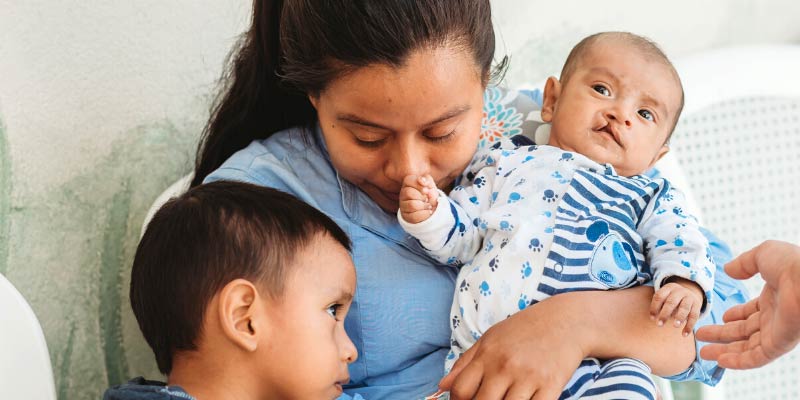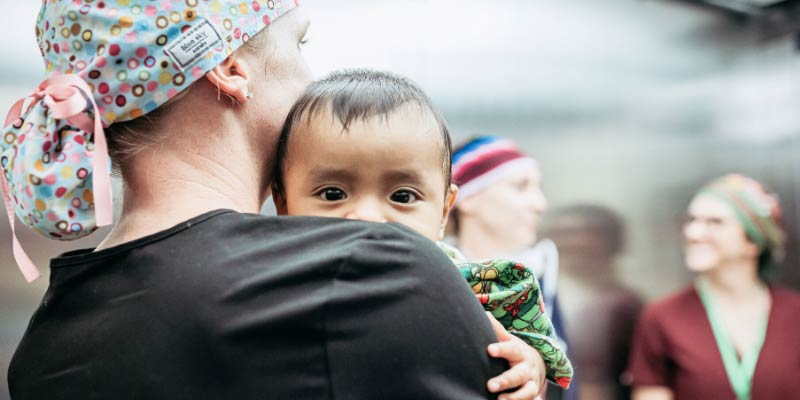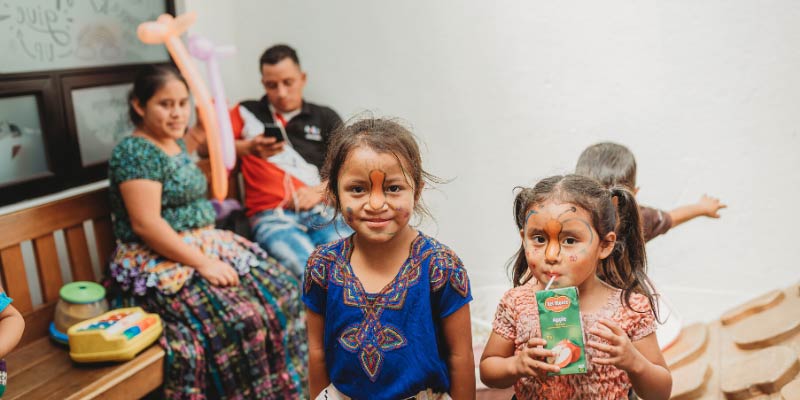by John Paschal
“Please put your tray tables up and your seats in the upright position,” comes the pleasant voice through the United jet, “as we prepare for our final descent.” The words, in a sense, are familiar territory, something we have all come to know, but the terrain below us is not as well situated in our understanding. Less than a mile below us, a gleaming lake is a light blue mirror of the sky we occupy.
Its shores, gently coiling, give way to irregular squares of green and brown farm plots. They seem a soft introduction to the city that sits on the south, still unseen. What awaits is an Austin Smiles medical mission to the capital of the Central American county of El Salvador. What awaits, as we will see, is a collection of dozens of children who need medical help, and a week of assistance to address that need.
Below us now is a green mountain where shiny-roofed houses hug wrinkled slopes. Wisps of gray-white clouds can scarcely conceal the steep terrain where the outer neighborhoods begin to take shape. Skinny tendrils of home tracts are perched on jagged ridges that crown the green valleys on either side.
Those homes, in a characteristic shared with homes beneath any incoming jet, conceal whatever infirmities its inhabitants might have. On approach, the mind will drift with the clouds: In what houses, beneath which of those sun-glinting roofs, are there kids whose infirmities will soon intersect the care provided by the 47 doctors, nurses, speech pathologists and other volunteers who are on this flight?
On the west, humpbacked hills and higher mountains roll toward a gauzy blue horizon. Roiling pillars of white smoke are slanting northward from little fires on rural land – trash fires, probably. At the edges of another blue lake, tightly bunched homes are clinging to dirt roads that follow the ridges toward the city. The ridges run to a wide valley that bends toward the ocean. At the center of the valley a light brown river is winding toward the blue Pacific. The ocean comes full into view just as the jet bends sharply to the left, more sharply now, as if the pilot forgot his toothbrush in Texas.
On the east is a high mountain. We slant toward the runway with tomorrow soon to arrive.
***
At 8:45 on Sunday morning, with a wind blowing warm through slatted windows of the military hospital, triage begins. Mothers with infants and toddlers are sitting on orange plastic chairs at either edge of a wide hallway whose walls are painted with bright murals of Winnie the Pooh and Tigger, too, and Nemo.
One by one, the children in the arms of their mothers are poised for evaluation in a small exam room just off the hallway. Inside are four plastic surgeons from Austin: Dr. Ned Snyder, the trip leader; Dr. Cameron Craven; Dr. Mahlon Kerr; and Dr. John McFate, each prepared to continue Austin Smiles’ 30-year history of medical missions to countries that have included 10 in Latin America. Across its 45 mission trips to El Salvador, Austin Smiles has helped 2,728 patients with craniofacial anomalies.
This year, like every year, the care comes free of charge.
Throughout the long day, the four plastic surgeons will determine whether each child is a suitable candidate for surgery, therapy or both. Those children – 120 in all, we have learned, up from the original 80 – are filling a pair of hallways now. Some are squirming, some crying, some at play. Not one is asleep.
Among the wide-awake children is nine-month-old Karina Isabel Vasquez Perez. Flashing alert brown eyes and a quick smile, she sits in the arms of her mother, Reyna. Karina has a cleft lip and cleft palate. On Jan. 17, Reyna took Karina to nearby Bloom Children’s Hospital for surgery. Staff there informed her that surgery could not be performed because Karina was ill. Today, says Reyna, she is hoping for a better outcome.
As if keen to the possibility, though not altogether cognizant of it, Karina is flashing her smile just as a motorcycle roars past the window. Wearing a light pink knit cap, a dark pink sweater, a white cotton shirt and wrapped in a thick maroon blanket, the child giggles and reaches out to her mother. She runs her small hands through Reyna’s shiny black hair.
“Sometimes she sees herself in the mirror and reaches to grab herself,” says Reyna with a laugh. “She thinks she’s another person.”
Maybe soon, in a sense, she will be.
***
It is just after 9 a.m., and inside the exam room at the edge of the crowded hall, the quartet of Austin-based plastic surgeons is evaluating the eighth patient of the fast-moving day. On the exam table is Alexander Hernandez, 11 months old. Wearing a onesie with white and green stripes, the child is lying on his back and whimpering. Wearing jeans and an Austin Smiles T-shirt, Dr. John McFate reaches down with his right hand and rubs the child gently on the belly. Alexander falls quickly silent and nearly still.
Alexander has come in the immediate wake of a quick succession of prospective surgery recipients. Not every child will be deemed a suitable candidate, and everyone knows it. “That can be sad, just like life can be sad,” Austin Smiles Mission Director Leilani Briseno told the assembled group of Austin Smiles volunteers just as the morning began. “As much as we want to, we can’t help every child. But just remember all the good we are doing in San Salvador.”
Some children will be deemed too small to safely undergo anesthesia, their bodies not yet big enough to handle the load. Others, just as Karina discovered at nearby Bloom, might be judged too ill. The lottery-like aspect of triage can carry a ponderous weight, the heavy awareness of the fortune and unfairness that can bear upon a population with unequal force.
So far this morning, however, six of the seven candidates in the plastic surgeons’ exam room — one of the three exam rooms currently engaged by the Austin Smiles team — have been green-lighted for surgery later this week. Right now, little Alexander is poised to be the eighth. As Dr. McFate gently soothes the child, Dr. Kerr examines the boy’s cleft lip and cleft palate with the efficiency of a man who knows others await.
The cries of those who come next have drifted into the exam room in a gathering of echoes.
“OK,” says Dr. Kerr to the other surgeons, “let’s do the lip now and then do the palate next year.”
The other doctors nod. It is an unspoken consensus. For none of the surgeons is this the first rodeo.
Turning to the lone non-doctor in the room – other than Alexander, of course – Dr. McFate explains that a lip procedure on Alexander this week will allow the tissue time to heal before palate surgery next year.
“That continuity is helpful,” adds Dr. McFate. “We can keep them in the system.”
***
At 9:55 a.m., in Dr. Ray Harshbarger’s exam room, continuity is made manifest in a blue-ink line across a page of my pocket notebook. More specifically, it is a timeline rendered by Dr. Sean Hill, a craniofacial surgery fellow at Dell Children’s Hospital in Austin, as a means of demonstrating the sequence of surgical procedures a juvenile patient might undergo throughout the service provided by Austin Smiles.
On the far left of the timeline is cleft lip surgery, performed when a child is as young as 10 weeks old. Next, to the right, is palate surgery at about 10 months. In the next few years might come surgery to correct speech, a bone graft, jaw surgery and then perhaps a rhinoplasty.
On the other side of the room, Dr. Harshbarger is discussing with the family of 14-year-old Daniela Veralice Burgos Aguilar a procedure that will address her diagnosis of hemifacial microsomia. Daniela, wearing a black T-shirt with white lettering that reads Infinity Love, is sitting on the exam table and listening as Dr. Harshbarger talks. The slight imbalance of her face is not enough to hide a pretty smile.
Moments later, Dr. Harshbarger stands at the exam table with a large aggregation of Austin Smiles team members. At the center of the group is Daniela, smiling more broadly now. Meanwhile, across the crowded room, Daniela’s mother, Mercedes, positions herself against a wall while holding a cellphone horizontally in efforts to frame the entire group. She snaps a digital photo.
“Gracias,” she says, smiling too. “Thank you.”
The plan for Daniela: an osteotomy with distractor placement.
In slightly more layman’s terms, if perhaps no easier to understand for anyone unaccustomed to surgery, Dr. Harshbarger this week will perform a procedure to lengthen the left side of Daniela’s jaw.
“One half of her face didn’t grow normally,” he explains, perhaps putting it as simply as he can to a man with a pocket notebook, “so we’re going to cut a line in her jaw and implant a distraction device.”
The device will be connected to a kind of dial to be turned twice a day. Each turn of the dial will expand the gap in Daniela’s jaw by half a millimeter, for a total of one millimeter per day. Meanwhile, a malleable callus will form to allow for further expansion of the jaw. Eventually, as the callus further widens to expand Daniela’s jawline, the body “will recruit cells and blood to help form and fuse bone.”
Still smiling, Daniela exits the room just as another patient crosses the threshold.
***
It is 10:45 a.m., exactly two hours after evaluations began, and the intersected hallways are still crowded with children and parents and the echoes of their voices. The busyness nearly overwhelms. As one story unfolds on the page, another dozen go unwritten. As one sentence unfurls its abridged descriptions, another 100 are permanently undone. Meanwhile, outside the window through which the warm wind blows, the volcano slopes to the street in another kind of permanence. It is always there.
At just before 11 a.m., in the exam room staffed by Dr. Syboney Zapata and speech language pathologist Julie Loney, 13-year-old Connie Gabriela Palomo Villarta is sitting on the exam table while her father, Norman, stands at her side. A pediatric ear, nose and throat surgeon, Dr. Zapata has begun examining Connie’s nasopharynx with a flexible endoscope, introducing the scope into Connie’s right nostril and guiding it to the back of her nose. The exam is uncomfortable for Connie but necessary. She winces slightly as Dr. Zapata guides the scope gently to its target. To comfort Connie, her dad pats her left knee.
“I want you to say some things,” Loney says pleasantly to Connie as she leans toward her.
Connie nods as her dad looks on.
“El pollo pico pan,” says Loney in Spanish.
“El pollo pico pan,” Connie repeats.
Peering at the image on the monitor, Dr. Zapata examines the muscles of Connie’s palate as the teenager speaks. With the procedure, the doctor and speech pathologist will determine whether Connie is a candidate for surgery – perhaps a pharyngoplasty or a pharyngeal flap – or for speech therapy.
More specifically, Dr. Zapata is examining the closure between the soft palate and the posterior pharynx to more closely study its circular constriction. Because of a craniofacial anomaly, Connie’s soft palate doesn’t close properly against the back of the throat. Consequently, air is emitted through her nasal passages instead of through her mouth when she speaks, which can make it difficult for people to understand her. As Dr. Zapata continues to study the images, Connie continues to repeat phrases at the pathologist’s request.
“Carlos come queso caliente,” says Loney.
“Carlos come queso caliente,” says Connie.
As Connie speaks with the scope inside her nasal passage, a tear streams slowly down her left cheek.
With his right thumb, her father wipes it away.
Within minutes the team has decided that Connie is a good candidate for a speech therapy research project conducted by Texas State University in San Marcos. The project is centered on the benefits of teletherapy.
Given the news, Norman kisses Connie on the forehead. She smiles. Turning to Loney and Dr. Zapata, he says, in English, “Thank you so much,” before hugging each of them and exiting to the crowded hallway.



